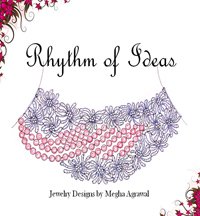Pearl - Oyster's Autobiography
Pearl is associated as June birthstone along with alexandrite. For
centuries, it has been used for adornment purpose.
While, all other birthstones are forms of different minerals, this jewel is organic in nature and created by living sea creatures.
Another difference is that, no faceting or polishing is done on this gem to enhance its natural beauty.
Color and Variety
It comes in different shapes and sizes. Although, this jewel is typically round in shape, but it is also found in drop, baroque, semi-round and free-form shape.
These gems come in a variety of colors, from pure white to pink, yellow, gray, black, blue, green, orange, brown, purple and multicolor.
Discussion on this gem will not be complete without the mention of Akoya Pearl. It is one of the most popular saltwater varieties. Although, common notion is that Akoya is farmed in Japan only, but not many people know that its smaller-sized variety comes from China.
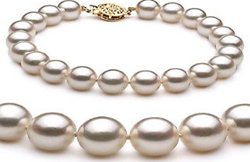 |
| Japanese Akoya |
Akoya is white in color, and is sometimes treated to impart black or a very dark blue color. It is bead-nucleated, which leads to its round shape. A consistent round shape and sharp luster distinguishes Akoya from its cousins.
Exotic varieties include White South Sea and Golden South Sea pearls. Former usually originates from the western coast of Australia and is noted for its large size and scarcity, while latter originates from the Philippines and Indonesia.
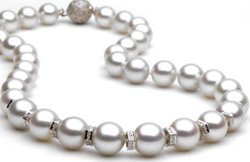 |
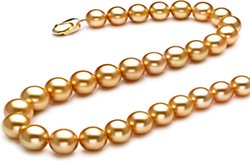 |
| White South Sea | Golden South Sea |
Another very popular kind of saltwater variety that entered the market in 1990’s is the Tahitian (also called "Black Pearl"). As its name suggests, it comes from the island of Tahiti in the Pacific Ocean and other islands in French Polynesia. It is found in colors like, green to blue, red, gold and black.
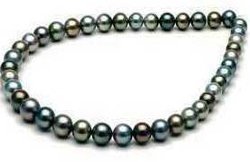 |
| Tahitian |
Tahitian variant is very much in trend and its popularity is growing by each passing day. Huge marketing campaigns were done to create awareness and to increase its popularity.
Formation Process
Natural varieties are the gift of Oysters (not the edible variety) and Mussels (found in fresh water lakes and rivers). When a foreign substance, such as a tiny sea parasite, accidentally finds its way into the oyster’s body and if it can’t get rid of it, then it becomes an irritant.
So, to soothe the irritation, the oyster produces an iridescent substance called nacre (nay-ker) with which it covers the intruder. This substance builds up over many years that finally results into this beautiful gem.
However, nowadays natural variety has become a rarity. Since the 1920s, cultured variants have almost completely replaced naturals in the market. Unless clearly mentioned "Natural Pearl", you should assume it as cultured. By the way, some cultured jewels are so fine that it is difficult to differentiate those from genuine natural piece.
Cultured varieties are also created by oyster in the same way, but the "irritant" is a shell bead that is implanted by man into the tissue of a live oyster. Over the period, (may be six months to many years) the oyster secrets the coating of nacre over it and thereby creating the jewel.
The thickness of nacre coating depends on the length of time the bead remains in oyster. If the gem is removed prematurely from oyster, then it will result into thin nacre coating that wears off in few years.
Contrary to saltwater variety which comes from oyster, freshwater gem is more abundant. Reason being that it comes from mussels (each mussel can produces up to 50 pieces) while, oyster can produce only one to three in its lifetime. But, freshwater varieties are comparatively less popular due to their irregular shapes.
Difference between Natural and Cultured
Rubbing of two pieces against each other or against a smooth surface is a common way of differentiating between a cultured and natural pearl. If rubbing is smooth, then it’s a cultured else it’s a natural one.
Natural and Cultured varieties can be distinguished using both by x-ray and microscope equipment that can examine the nucleus of gem. When X-ray is passed through a cultured with bead, it reveals a different structure to that of a natural variety.
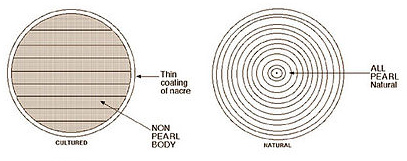 |
| Cross-sectional view of cultured and natural jewel |
A beaded cultured variety shows a solid center with no concentric growth rings, whereas a natural one shows a series of concentric growth rings. A bead-less cultured (whether of freshwater or saltwater origin) may show growth rings, but also a complex central cavity.
According to ancient legend, the moon
holds the power to create pearls, instilling them with a celestial glow.
Gemvara offers cultured varieties in an unprecedented palette of your
choice of six lustrous natural hues from lakes and oceans around the
world.
Uses
Medicinal
The healing properties of this jewel are known to be effective for health problems relating to heart and stomach.
Ornamental
All colors and types of the jewel are used as gemstones, and these are especially popular as necklaces. It also popularly used as the center stone in pearl engagement rings. Diamond and pearl earrings, bracelets, and pendants are also in trend.
In order to get the unique shape, irregular-shaped pearls are used for pendants or rings. Its jewelry is suitable for all ages, and elegantly blends with all outfits from jeans to an evening dress.
Popular Gift Choice
This gem has always been symbol of class, purity and mark of taste. It's a popular gift choice for a marriage or the birth of a child.
Other Uses
This gem is also ground and actively used in cosmetics, medicines, and in paint formulations. In the past and even today they are stitched onto lavish designer clothing.
Value
A fine natural variety has always been considered a precious gem because of its rarity. Nowadays, due to upward trend in demand, even a fine cultured variant is also very expensive.
The actual value of a natural jewel is determined in the same way as it would be for other "precious" gems. The valuation factors include size, shape, color, surface quality, luster and nacre thickness. This jewel is typically most valuable when in a perfect round shape.
Also, if you are intending to use this gem in matching pairs (earrings) or pearls are strung on a strand, then total cost could be high. This is because sorting and sourcing of matching pearls - so that the strand look consistent - is a labor intensive process which can raise the price.
Grading System
There is no standard grading system for this jewel. Generally the AAA grading system or a variation of this system is followed. While buying you should carefully check the grade and description. The percentage of blemish is a good indicator of the quality. Highest quality jewel should be 95-99% blemish free.
Care and Cleaning
On Mohs Scale of hardness, this gem is rated 2.5 – 4.5. Thus, it can be said to be delicate and utmost care should be taken when wearing, handling or cleaning them.
- Do not wear this beautiful gem when the string is wet. Wet strings can stretch and may break. Also it gets dirty, which is hard to clean. Do not hang these jewels to dry, leave it on surface and let it dry naturally.
- Take your Pearls off when applying cosmetics, hair spray, and perfume, or when showering or swimming. Have these gems restrung once a year if you wear them often.
- Only use appropriate jewelry cleaners for cleaning this gem jewelry. Never use an ultrasonic cleaner, steam-cleaner, detergents, bleaches, powdered cleansers, baking soda, or ammonia-based cleaners.
- Never use toothbrushes or abrasive materials to clean this jewel.
Return to Diamond Jewelry Homepage
I hope you'll not mind sharing this on Twitter, Facebook and with everyone else :)
Feel free to share if something is in your mind and want it to be covered on this site.
My Newsletter
Did you liked this article? Sign-up my FREE weekly newsletter and I'll send you more awesome new additions on this website along with latest jewelry happenings around the world, and download my Jewelry Design Album for FREE!
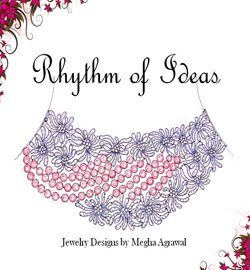 |
|

